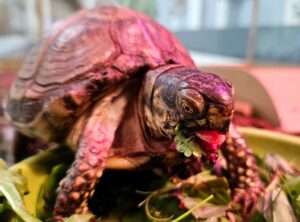By Kennedy Zittel, naturalist
 Here at Woodland Dunes, we have two education turtles: a three-toed box turtle (Sheldon) and an ornate box turtle (Sergio). During winter, the two turtles like to spend their time snoozing under their substrate. This is called brumation – when a reptile or amphibian enters a state of inactivity during the winter.
Here at Woodland Dunes, we have two education turtles: a three-toed box turtle (Sheldon) and an ornate box turtle (Sergio). During winter, the two turtles like to spend their time snoozing under their substrate. This is called brumation – when a reptile or amphibian enters a state of inactivity during the winter.
This isn’t true hibernation, as they will wake up every so often to get a drink or a bite to eat. Recently, Sheldon (the three-toed box turtle) has been waking up more and more. Sheldon often can be seen peering out from behind one of their log hideouts, keeping a watchful eye over the education room.
Last week, we placed a strawberry in their food dish for a mid-day treat. With lightning-fast speed (well… for a turtle at least) the race was on to reach the berry. That had me wondering, how did they know so quickly that there was a delicious berry awaiting them?
It turns out that not all of their senses are very good, for example, they do not have a good sense of hearing. Box turtles do not have external ears, they have a layer of skin on either side of their head behind their eyes that covers their middle and inner ear. They are not deaf but do not hear nearly as well as other animals can.
Box turtles do have an excellent sense of smell and sight though, both of which likely alerted them to one of their favorite snacks! A box turtle’s sense of smell can help them find food, mates, territories, and help them avoid predators out in the wild.
Box turtles also have good eyesight. Previously people thought that they were colorblind, but they can actually see more colors than humans can! This is because turtles have tetrachromatic vision (meaning they see color through 4 types of cones compared to our 3). Turtles have a special gene called the CYP2J19 Gene, also called the Red Gene. Animals with the Red Gene can see more shades of red than we and a lot of other mammals can see. As you can imagine, that bright red strawberry probably stood out like a flashing “come and get it!” sign. Yum!
Though the turtles are likely unable to hear the families in the education room’s laughter and nature discoveries, they can watch as kids put on nature puppet shows, learn how to use binoculars and microscopes, and play with other nature-related items. The next time you visit, stop by the turtle enclosure and see if you can spot one of them gazing out over the room – give a little wave because though they likely will not wave back – they can see you saying hello!
photo by Kennedy Zittel
